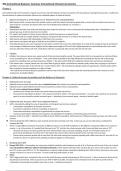Samenvatting
Summary International Monetary Economics- 3BA: International Business
- Instelling
- Vrije Universiteit Brussel (VUB)
This is a summary for the whole course of International monetary economics, based on slides, notes and the book.
[Meer zien]





